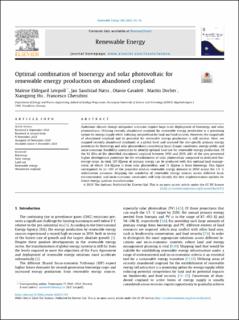| dc.contributor.author | Leirpoll, Malene Eldegard | |
| dc.contributor.author | Næss, Jan Sandstad | |
| dc.contributor.author | Cavalett, Otávio | |
| dc.contributor.author | Dorber, Martin | |
| dc.contributor.author | Hu, Xiangping | |
| dc.contributor.author | Cherubini, Francesco | |
| dc.date.accessioned | 2021-04-21T10:58:32Z | |
| dc.date.available | 2021-04-21T10:58:32Z | |
| dc.date.created | 2020-12-30T13:19:59Z | |
| dc.date.issued | 2021 | |
| dc.identifier.citation | Renewable Energy. 2021, 168, 45-56. | en_US |
| dc.identifier.issn | 0960-1481 | |
| dc.identifier.uri | https://hdl.handle.net/11250/2738855 | |
| dc.description.abstract | Ambitious climate change mitigation scenarios require large-scale deployment of bioenergy and solar photovoltaics. Utilizing recently abandoned cropland for renewable energy production is a promising option for energy supply while reducing competition for land and food security. However, the magnitude of abandoned cropland and its potential for renewable energy production is still unclear. Here, we mapped recently abandoned croplands at a global level and assessed the site-specific primary energy potentials for bioenergy and solar photovoltaics considering local climatic conditions, energy yields, and socio-economic feasibility constraints to identify optimal land use for renewable energy production. Of the 83 Mha of the identified abandoned cropland between 1992 and 2015, 68% of the area presented higher development potentials for the establishment of solar photovoltaic compared to dedicated bioenergy crops. In total, 125 EJ/year of primary energy can be produced with this optimal land management, of which 114 EJ/year is from solar photovoltaic and 11 EJ/year is from bioenergy. This figure corresponds to 33–50% of the projected median renewable energy demand in 2050 across the 1.5 °C stabilization scenarios. Mapping the suitability of renewable energy sources across different local, environmental, and socio-economic constraints will help identify the best implementation options for future energy systems transformation. | en_US |
| dc.language.iso | eng | en_US |
| dc.publisher | Elsevier Science | en_US |
| dc.rights | Navngivelse 4.0 Internasjonal | * |
| dc.rights.uri | http://creativecommons.org/licenses/by/4.0/deed.no | * |
| dc.title | Optimal combination of bioenergy and solar photovoltaic for renewable energy production on abandoned cropland | en_US |
| dc.type | Peer reviewed | en_US |
| dc.type | Journal article | en_US |
| dc.description.version | publishedVersion | en_US |
| dc.source.pagenumber | 45-56 | en_US |
| dc.source.volume | 168 | en_US |
| dc.source.journal | Renewable Energy | en_US |
| dc.identifier.doi | 10.1016/j.renene.2020.11.159 | |
| dc.identifier.cristin | 1864086 | |
| dc.relation.project | Norges forskningsråd: 286773 | en_US |
| dc.relation.project | Norges forskningsråd: 294534 | en_US |
| dc.relation.project | Norges forskningsråd: 257622 | en_US |
| dc.description.localcode | This is an open access article distributed under the terms of the Creative Commons CC-BY license, which permits unrestricted use, distribution, and reproduction in any medium, provided the original work is properly cited. | en_US |
| cristin.ispublished | true | |
| cristin.fulltext | original | |
| cristin.qualitycode | 1 | |

